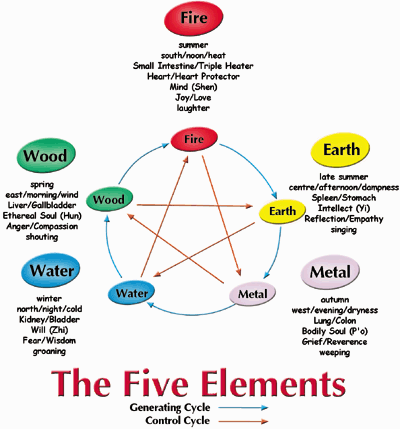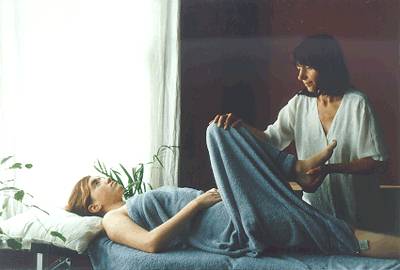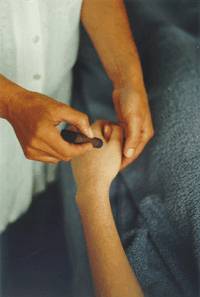Positive Health Online
Your Country

Remove bookmark
Aromatherapy, Massage and Chinese Medicine
listed in aromatherapy, originally published in issue 33 - October 1998
Chinese Medicine
The physical and mental disorders of the individual too often reflect imbalances in the world at large. In Chinese medicine it was deemed important to bring the energy of the body into balance with the natural environment. Disease was attributable to changes brought about by the weather, the seasons or personal infringement of the natural law.
There was a constant reminder that we ‘are part of Nature and channelled into the cycles of Nature’. Hence the Five Element theory which provides us with a set of correspondences by which we can link our physical and psychological characteristics with the seasons, the elements, times of day, specific foods, animals and so on. In ancient rural China this was a far simpler process than in modern Western highly urbanised society and, yet, I believe the rules remain unchanged. The health and sense of well-being of the individual is in direct relationship with his or her social and environmental matrix. This includes such factors as the quality of our food and water, the air we breathe, weather conditions, relaxation, sleep, work, exercise and relationships of all kinds.
In our current attempt to control, manipulate and exploit both natural and human ‘resources’, often solely in the search of short-term profit, we are violating laws that will only lead to a rising incidence of physical and mental ill-health. Many of our illnesses today are related to stresses, such as increased pressure in working and family life and the increasing toxicity in our food, air and water in the form of complex cocktails of chemicals and radiations. As individuals, we have certain immediate choices we can make in regard to our health, such as how much we choose to smoke or drink or how much exercise we take. Ultimately, however, we may have to look further at the wider political and economic structures if we are to achieve a society which is more in tune with natural forces and more caring of our health and well-being.

If we look at the principles of Chinese medicine we see that, like everything else in the universe, our bodies can be classified according to the two distinct forces of Yin and Yang. These forces are in constant interplay. The Yin force is more substantial and is associated with the interior front and lower parts of the body. It moistens and cools. It is associated with night and darkness and promotes relaxation and sleep. Yin is more heavy and material and will condense and contract. It is associated with the earth, the moon, autumn, winter, decrease and inwardness. A person who is deficient in Yin may suffer slight fever or feelings of heat in the late afternoon, night sweating and a dry throat at night, difficulty sleeping, anxiety and restlessness. The tongue will be red, peeled and cracked. This is because the cooling moistening grounding aspects of Yin are not apparent. As an aromatherapist, I use the oils of rose and geranium to support the function of Yin. These oils are often used during the menopause when the Yin energy of the woman is depleted.
Yang is associated with the back, exterior and upper parts of the body. It is energising, moving and less substantial. It is hot and dry and associated with day, the sun, spring, summer, increase and expansion. If Yang in the body is deficient, the person may be cold, pale, depressed and lethargic. The tongue will be pale with a white coating and the pulse weak. Essential oils which promote Yang in the body are warm tonifying oils such as ginger, rosemary, thyme and cinnamon. These are herbs and spices we instinctively use in winter to counteract the cold Yin time of year along with warming, cooked food.
If Yang is in excess, there will be too much heat and activity in the body resulting in fever, burning pains, inflammation, dryness, red tongue and rapid pulse. The differences between excess Yang and deficient Yin is that one is a ‘full’ overactive condition and the other an ‘empty’ depleted condition. Essential oils to counteract excess Yang are cooling, moistening oils such as lavender, lemon, camomile and melissa. Our diet should have a preponderance of raw, cooling foods such as salads and fruit.
Yin and Yang are relative terms and the aim of the practitioner is always to achieve a greater sense of equilibrium. There is however, never a point of stasis. The universe is seen to be in constant flux between these two forces as night follows day and autumn and winter follow spring and summer. Autumn and winter were seen as times of rest when we should sleep longer and conserve our energy. Spring and summer were times of increased work and activity. In our hectic modern world we no longer allow for such observances. Electric light enables us to work both day and night indiscriminately and the grind of work and time schedules goes on with a relentlessness which holds no regard for the seasons. Few bosses would be impressed if we demanded a shorter working day in the winter because it was cold and dark and our bodies needed more rest!
The truth is that most of us feel that we no longer have the privilege of listening to the energy needs of our bodies and acting accordingly. Instead we opt for yet another course of antibiotics which we hope will enable us to carry on ‘as normal’ as quickly as possible. In this way, energetic imbalances are not resolved, but driven further inwards until they finally erupt in serious conditions such as cancer, ME, auto-immune diseases, heart problems and so on.
Despite these difficulties of modern living we can learn to be more observant of ourselves and our environment and start to make the necessary changes. This may mean campaigning for more locally-grown organic foods and less polluted air or simply using such tools as aromatherapy, massage, acupressure and relaxation techniques to help bring balance back into our personal lives.
In my practice I use a combination of massage techniques, aromatherapy, acupressure, passive stretches and moxibustion.
Chinese Massage
How Does Chinese Massage Differ from Western Massage?
All massage is designed to promote circulation and release tension. Chinese massage is not only concerned with the circulation of Qi energy. Imbalance and blockages in the flow of Qi were seen to be the root cause of all illness in the body. Chinese massage is therefore designed not only to relax the person and release muscular tension but also to treat illnesses. To do this, it combines a wide variety of massage techniques with acupressure and stretches and massage of the meridians. The practitioner first needs to diagnose where the imbalances in the body lie. For example, which organs and meridians are affected and in what way the forces of Yin and Yang are in excess or deficient. A number of diagnostic techniques may be used, from questioning, looking, listening to, observing the tongue, feeling the pulse, and so on. The massage can range from deep tissue massage to the lighter effects of dotting or nipping. Some of the strokes belong to Yang and have a forceful, purging effect; others belong to Yin and have tonifying, invigorating effects. Acupressure
Acupressure uses the same points on the meridians as are used in acupuncture. Rather than using needles, gentle finger pressure or rubbing is applied. It can be used to treat both general health conditions and specific points of pain or injury. It is easily incorporated into the general massage. Acupressure will regulate and normalise blocked energy in the meridians, thus regulating the balance of Yin and Yang and stimulating the flow of blood and Qi. Meridian Massage and Passive Stretches
The meridians or lines of energy in the body may themselves be massaged or stretched. Finger pressure along the meridian will release any blockages and stretching the appropriate part of the body will enhance the flow of Qi. For example, massaging and stretching the Lung meridian can improve breathing and stimulate the immune system. Moxibustion
Moxibustion treats and prevents disease by applying heat to specific locations. Moxawool is used in the form of a stick or cone and consists of a particular herb, Artemisia vulgaris, which, when burnt, produces a mild heat able to penetrate deeply into the muscle. It is excellent for treating chronic pain and conditions of chronic fatigue. As it is ‘warm and dry’, it is used to counteract cold, damp conditions where Yang is deficient.
Aromatherapy
Aromatherapy can be used in conjunction with Chinese massage in that the essential oils can also be categorised according to the principles of Chinese medicine. A few examples of this are shown in Table 1.
Table 1 |
|||
|
Essential oil |
Energy | Main Element | Action |
| Bergamot | Cool and dry | Wood | Smoothes flow of Qi, harmonises Liver Qi |
| Juniper | Hot and dry | Water and metal | Stimulates Yang energy (especially Kidney Yang) |
| Marjoram | Slightly warm and dry | Earth and fire | Moves Qi, calms the heart, tonifies Spleen Yang, clears dampness |
| Palmarosa | Cool and moist | Fire | Clears heat and strengthens Yin |
Mind and body are inextricably linked, hence our emotional life can cause imbalances in the same way as our physical, for example, grief and sadness which are associated with the Metal element can result in weakened Lung Qi. The person may experience recurring respiratory infections. They may feel withdrawn, cut off from others and have difficulty communicating. In this case oils such as eucalyptus, cypress, frankincense, tea tree and clary sage will not only support the immune system ‘Defensive’ Qi, but help the individual to let go of grief and be more communicative. Acupressure points such as Lung 7 and Lung 9 will support this process. Someone who seriously overworks is likely to deplete Kidney Qi and Yin. As a result they may feel anxious, tired and depleted. Geranium oil would be used to support the Yin as would acupressure points such as Kidney 6 and Renal 4. Having worked for many years in mental health and also with HIV/Aids, I find this approach particularly useful, as it sees both physical and emotional disturbances as one.
Case study
As a final case study, I would like to cite the example of a woman aged 41 who came to me having suffered extrinsic asthma for many years. Her thoracic area was expanded and tight. Her neck was tight and her chest concave. She felt the cold a lot, especially in her hands and feet and was prone to recurring chest infections especially during autumn and winter. She wheezed a lot on exertion and her face was pale with dark rings under her eyes, her tongue pale and voice weak. She felt very tired. Long-standing asthma and weak Lung Qi had affected Kidney Qi and Kidney Yang, hence the feelings of cold and fatigue and breathlessness on exertion. During the treatment, I used moxibustion to raise lungs and Kidney Qi and to raise the Yang energy of the body generally. I used oils of eucalyptus, ravensara, lavender, pine and thyme to support Kidney Yang and Defensive Qi and ease the breathing. The massage eased overall body tension concentrating particularly on the upper back, neck and chest and jaw. (Massage around the mandibular region stimulates meridians which ‘magically’ open up the ribs and hips.) I also encouraged movement of the eyes and jaw. I worked the lung meridian and applied passive stretches of the arms to stretch the meridian and open up the chest. I massaged acupressure points to tonify lung and kidney energy and release congestion in the chest. I also worked the reflex ‘lung’ area on the feet. After the massage she felt greatly relaxed, her breathing had eased considerably and her energy was enhanced.
I then showed her simple exercises to help raise Lung and Kidney Qi and gentle ways of easing tensions in the chest. We discussed what external factors affected her asthma in terms of weather conditions, temperature, food, pollutants, emotional stress and so on. This helped her to determine what immediate changes she could make in her life to relieve the condition and what might be longer-term goals. It empowered her to take responsibility for the environment in relation to her own health.
References:
Chengnan, S (ed.) (1990) Chinese Massage Therapy Shandong Science and Technology PressChia, M and M (1990) Chi Nei Tsang Internal Organs Chi Massage Healing Tao Books
Jwing-Ming, Y (Dr) (1922) Chinese Qigong Massage YMAA Publication Centre
Maciocia, G (1989) The Foundations of Chinese Medicine Churchill Livingstone
Mojay, G (1996) Aromatherapy for Healing the Spirit Gaia Books Ltd.
Turner and Low (1981) The Principles and Practice of Moxibustion Thorsons
Xinnong, C (ed.) (1987) Chinese Acupuncture and Moxibustion Foreign Languages Press, Beijing
Zhao-Pu, W (1991) Acupressure Therapy Churchill Livingstone.
Comments:
-
No Article Comments available